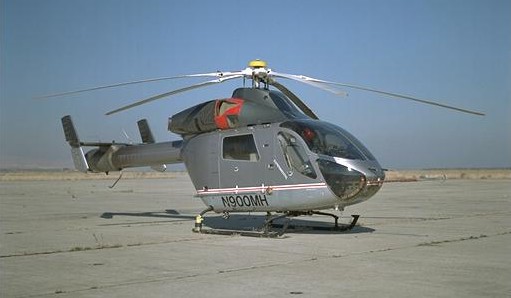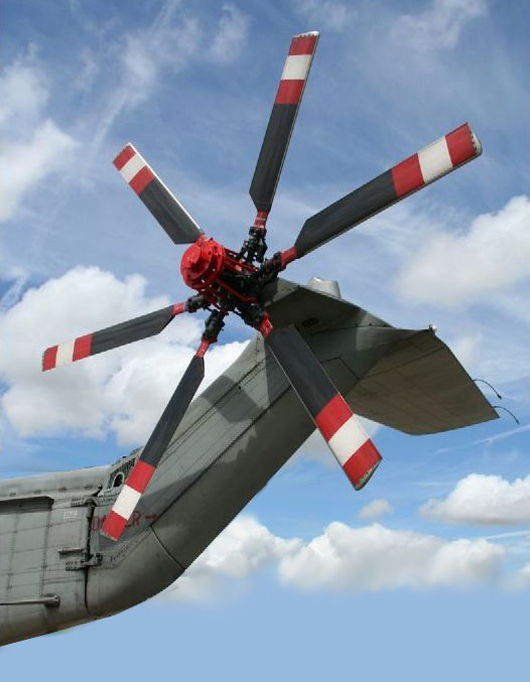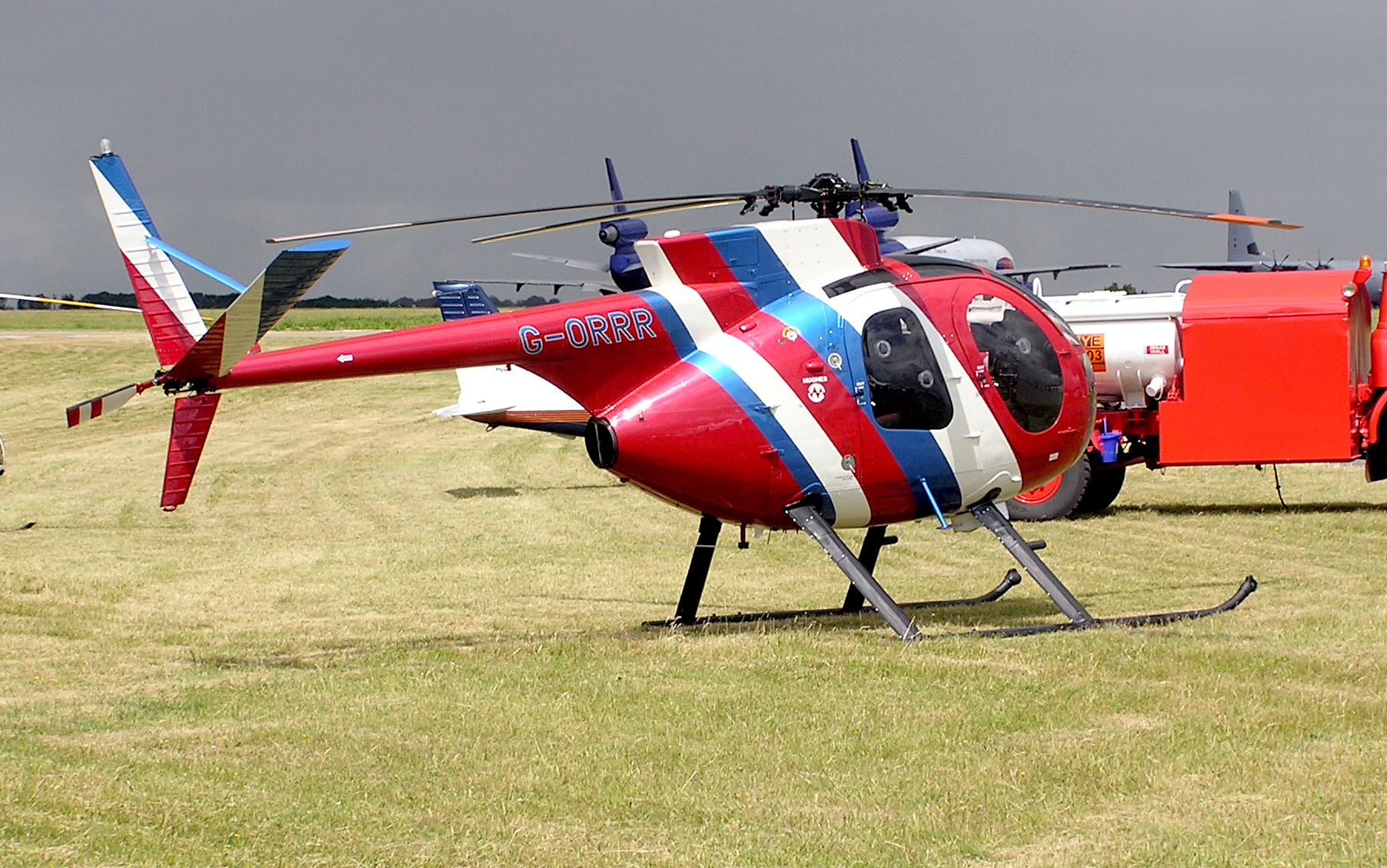|
NOTAR
NOTAR ("no tail rotor") is a helicopter system which avoids the use of a tail rotor. It was developed by McDonnell Douglas Helicopter Systems (through their acquisition of Hughes Helicopters). The system uses a fan inside the tail boom to build a high volume of low-pressure air, which exits through two slots and creates a boundary layer flow of air along the tailboom utilizing the Coandă effect. The boundary layer changes the direction of airflow around the tailboom, creating thrust opposite the motion imparted to the fuselage by the torque effect of the main rotor. Directional yaw control is gained through a vented, rotating drum at the end of the tailboom, called the direct jet thruster. Advocates of NOTAR believe the system offers quieter and safer operation over a traditional tail rotor. Development The use of directed air to provide anti-torque control had been tested as early as 1945 in the British Cierva W.9. During 1957, a Spanish prototype designed and built by Aerot ... [...More Info...] [...Related Items...] OR: [Wikipedia] [Google] [Baidu] |
MD Helicopters MD Explorer
The MD Helicopters MD Explorer is a light twin-engined utility helicopter designed and initially produced by the American rotorcraft specialist McDonnell Douglas Helicopter Systems. On 18 December 1992, the maiden flight was conducted, initial certification for the type followed roughly two years later. The initial model, the MD 900, was joined by an improved successor, the MD 902, during the late 1990s. The Explorer is currently produced by MD Helicopters. Development In January 1989, McDonnell Douglas Helicopters officially announced the launch of the Explorer, which it initially referred to as the ''MDX''. Amongst other things, the Explorer was the first McDonnell Douglas helicopter to incorporate the NOTAR system from its initial design.Frawley 2003, p. 156. McDonnell Douglas partnered with Hawker de Havilland of Australia, which handled the manufacturing of the airframes. A total of ten prototypes were constructed, seven of which being used for ground-based tests. McDonnel ... [...More Info...] [...Related Items...] OR: [Wikipedia] [Google] [Baidu] |
Tail Rotor
The tail rotor is a smaller rotor mounted vertically or near-vertically at the tail of a traditional single-rotor helicopter, where it rotates to generate a propeller-like horizontal thrust in the same direction as the main rotor's rotation. The tail rotor's position and distance from the helicopter's center of mass allow it to develop enough thrust leverage to counter the reactional torque exerted on the fuselage by the spinning of the main rotor. Without the tail rotor or other anti-torque mechanisms (e.g. NOTAR), the helicopter would be constantly spinning in the opposite direction of the main rotor when flying. Tail rotors are simpler than main rotors since they require only collective changes in pitch to vary thrust. The pitch of the tail rotor blades is adjustable by the pilot via the anti-torque pedals, which also provide directional control by allowing the pilot to rotate the helicopter around its vertical axis. Its drive system consists of a shaft powered from the mai ... [...More Info...] [...Related Items...] OR: [Wikipedia] [Google] [Baidu] |
Coandă Effect
The Coandă effect ( or ) is the tendency of a fluid jet to stay attached to a convex surface. ''Merriam-Webster'' describes it as "the tendency of a jet of fluid emerging from an orifice to follow an adjacent flat or curved surface and to entrain fluid from the surroundings so that a region of lower pressure develops." It is named after Romanian inventor Henri Coandă, who was the first to recognize the practical application of the phenomenon in aircraft design around 1910. It was first documented explicitly in two patents issued in 1936. Discovery An early description of this phenomenon was provided by Thomas Young in a lecture given to The Royal Society in 1800: A hundred years later, Henri Coandă identified an application of the effect during experiments with his Coandă-1910 aircraft, which mounted an unusual engine he designed. The motor-driven turbine pushed hot air rearward, and Coandă noticed that the airflow was attracted to nearby surfaces. In 1934 Coandă obt ... [...More Info...] [...Related Items...] OR: [Wikipedia] [Google] [Baidu] |
MD Helicopters
MD Helicopters, LLC. (formerly McDonnell Douglas Helicopter Systems) is an American aerospace manufacturer. It produces light utility helicopters for commercial and military use. The company was a subsidiary of Hughes Aircraft until 1984, when McDonnell Douglas acquired it and renamed it McDonnell Douglas Helicopter Systems. It later became MD Helicopters in the late 1990s when McDonnell Douglas merged with Boeing. History The company began in 1947 as a unit of Hughes Aircraft, then was part of the Hughes Tool Company after 1955. It became the helicopter division of Hughes' Summa Corporation in 1972, and was finally reformed as Hughes Helicopters, Inc. in 1981. However, throughout its history, the company was informally known as Hughes Helicopters. The company was sold to McDonnell Douglas in 1984. Hughes Helicopters produced three major designs during its 37-year history. The Model 269/300 was Hughes' first successful helicopter design. Built in 1956, and entering producti ... [...More Info...] [...Related Items...] OR: [Wikipedia] [Google] [Baidu] |
Helicopter
A helicopter is a type of rotorcraft in which lift and thrust are supplied by horizontally spinning rotors. This allows the helicopter to take off and land vertically, to hover, and to fly forward, backward and laterally. These attributes allow helicopters to be used in congested or isolated areas where fixed-wing aircraft and many forms of STOL (Short TakeOff and Landing) or STOVL (Short TakeOff and Vertical Landing) aircraft cannot perform without a runway. In 1942, the Sikorsky R-4 became the first helicopter to reach full-scale production.Munson 1968.Hirschberg, Michael J. and David K. Dailey"Sikorsky". ''US and Russian Helicopter Development in the 20th Century'', American Helicopter Society, International. 7 July 2000. Although most earlier designs used more than one main rotor, the configuration of a single main rotor accompanied by a vertical anti-torque tail rotor (i.e. unicopter, not to be confused with the single-blade monocopter) has become the most comm ... [...More Info...] [...Related Items...] OR: [Wikipedia] [Google] [Baidu] |
MD Helicopters MD 600
The MD Helicopters MD 600N is a light utility civilian helicopter designed in the United States. It is a stretched eight-seat development of the five-seat MD 520N helicopter. Design and development McDonnell Douglas Helicopter Systems (MD Helicopters since 1999) first announced it was developing a stretched MD 520N in late 1994, at that time designated the MD 630N.Frawley, Gerard: ''The International Directory of Civil Aircraft, 2003–2004'', page 156. Aerospace Publications Pty Ltd, 2003. . The prototype, a modified MD 530F, had made its first flight on November 22, 1994. McDonnell Douglas gave the go-ahead for the production aircraft, redesignated the MD 600N, in March 1995. McDonnell Douglas stretched the MD 520N fuselage by inserting a plug aft of the cockpit/cabin bulkhead and stretching the NOTAR tail boom. The larger fuselage allows for an extra (middle) row of seats. Other differences compared with the MD 520N include a new six blade main rotor (the MD 520N has a five ... [...More Info...] [...Related Items...] OR: [Wikipedia] [Google] [Baidu] |
MD Helicopters MD 500
The MD Helicopters MD 500 series is an American family of light utility civilian and military helicopters. The MD 500 was developed from the Hughes 500, a civilian version of the US Army's OH-6A Cayuse/Loach. The series currently includes the MD 500E, MD 520N, and MD 530F. The MD 500 was initially produced by Hughes Helicopters as the ''Hughes 500''. Since being introduced in 1967, numerous models have been produced, often featuring a more powerful engine or a five-bladed main rotor in place of the original four-blade counterpart. The MD 500 has been commonly used for utility work, particularly the ''MD 530F''; it has also proven to be popular with law enforcement agencies. Production of the type was continued into the twenty-first century by Hughes' successor companies, McDonnell Douglas Helicopter Systems, and subsequently MD Helicopters. While the MD 500 series has been largely operated by civil customers, it has occasionally seen military use, even to the extent of performi ... [...More Info...] [...Related Items...] OR: [Wikipedia] [Google] [Baidu] |
Youngcopter Neo
The Youngcopter Neo () is a German NOTAR helicopter that was designed by Björn Jung and is under development by his company, Youngcopter of Mainz. It was first publicly introduced at the ILA Berlin Air Show in 2008. The aircraft is intended to be supplied as a kit for amateur construction.Tacke, Willi; Marino Boric; et al: ''World Directory of Light Aviation 2015-16'', page 212. Flying Pages Europe SARL, 2015. No projected date has been announced for kit deliveries and no pricing has been set as of January 2018. Design and development The Neo was designed to comply with the amateur-built aircraft construction rules. The first prototype was completed in 2008 and ground run. By 2010 ground testing had been completed, including rotor system tracking and balancing. The prototype first flew in hovering flight on 31 October 2011 and developmental hover flight testing continued through 2015. The Neo design features a single main rotor, with no tail rotor, a two-seats-in side-by-s ... [...More Info...] [...Related Items...] OR: [Wikipedia] [Google] [Baidu] |
Hughes Helicopters
Hughes Helicopters was a major manufacturer of military and civil helicopters from the 1950s to the 1980s. The company began in 1947, as a unit of Hughes Aircraft, then was part of the Hughes Tool Company after 1955. It became the Hughes Helicopter Division, Summa Corporation in 1972, and was reformed as Hughes Helicopters, Inc. in 1981. However, throughout its history, the company was informally known as "Hughes Helicopters". It was sold to McDonnell Douglas in 1984 and made a subsidiary under the name ''McDonnell Douglas Helicopter Systems''. See MD Helicopters for history of the company after this acquisition. In 1997 McDonnell Douglas merged with Boeing with Boeing as the surviving company. History In 1947, Howard Hughes redirected the Hughes Aircraft Company's efforts from airplanes to helicopters. The effort began in earnest in 1948, when helicopter manufacturer Kellett Autogiro Corporation sold their latest design to Hughes for production. The XH-17 "Sky Crane" firs ... [...More Info...] [...Related Items...] OR: [Wikipedia] [Google] [Baidu] |
Fenestron
A Fenestron (sometimes alternatively referred to as a fantail or a "fan-in-fin" arrangementLeishman 2006, p. 321.) is an enclosed helicopter tail rotor that operates like a ducted fan. The term ''Fenestron'' is a trademark of multinational helicopter manufacturing consortium Airbus Helicopters (formerly known as Eurocopter). The word itself comes from the Occitan term for a ''small window'', and is ultimately derived from the Latin word ''fenestra'' for ''window''.Prouty, Ray. ''Helicopter Aerodynamics'', Helobooks, 1985, 2004. p. 266. The Fenestron differs from a conventional open tail rotor by being integrally housed within the tail boom, and like the conventional tail rotor it replaces, functions to counteract the torque generated by the main rotor. While conventional tail rotors typically have two or four blades, Fenestrons have between seven and eighteen blades; these may have variable angular spacing so that the noise is distributed over different frequencies. By placing t ... [...More Info...] [...Related Items...] OR: [Wikipedia] [Google] [Baidu] |
OH-6 Cayuse
The Hughes OH-6 Cayuse is a single-engine light helicopter that was designed and produced by the American aerospace company Hughes Helicopters. Its formal name is derived from the Cayuse people while its "Loach" nickname comes from the acronym for the Light Observation Helicopter (LOH) programme that it was procured under. The OH-6 was developed in response to the United States Army issuing Technical Specification 153 in 1960 to replace its Bell H-13 Sioux fleet. The ''Model 369'' was submitted by Hughes, and competed against the two finalists, Fairchild-Hiller and Bell, for a production contract. On 27 February 1963, the first prototype conducted its maiden flight. The Model 369 had a distinctive teardrop-shaped fuselage that had strong crashworthiness properties and provided excellent external visibility. Its four-bladed full-articulated main rotor made it particularly agile, and it was suitable for personnel transport, escort and attack missions, and observation. During May ... [...More Info...] [...Related Items...] OR: [Wikipedia] [Google] [Baidu] |
.jpg)







.jpg)
